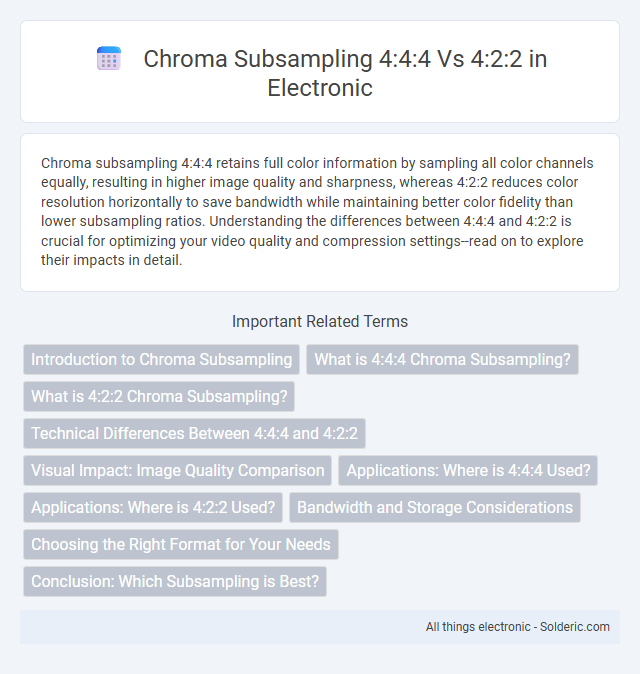Chroma subsampling 4:4:4 retains full color information by sampling all color channels equally, resulting in higher image quality and sharpness, whereas 4:2:2 reduces color resolution horizontally to save bandwidth while maintaining better color fidelity than lower subsampling ratios. Understanding the differences between 4:4:4 and 4:2:2 is crucial for optimizing your video quality and compression settings--read on to explore their impacts in detail.
Comparison Table
| Feature | 4:4:4 | 4:2:2 |
|---|---|---|
| Chroma Sampling | No subsampling (full chroma resolution) | Horizontal chroma subsampling (50% chroma data) |
| Color Fidelity | Highest, ideal for color-sensitive work | Moderate, good for broadcast and video |
| Bandwidth | High bandwidth and data rate | Lower bandwidth compared to 4:4:4 |
| Use Cases | Professional graphics, visual effects, professional video editing | Broadcast TV, streaming, HD video production |
| Compatibility | Supported by high-end professional devices | Widely supported by consumer and professional equipment |
Introduction to Chroma Subsampling
Chroma subsampling reduces color information in video signals to optimize bandwidth while maintaining visual quality, crucial for efficient video compression. The 4:4:4 format preserves full color detail by sampling both luminance and chrominance equally, making it ideal for color-critical applications like professional video editing. In contrast, 4:2:2 subsampling halves the horizontal chroma resolution, balancing reduced file size with good image quality, suitable for broadcast and streaming where efficient data usage matters.
What is 4:4:4 Chroma Subsampling?
4:4:4 chroma subsampling retains full color information for every pixel, ensuring no color data is lost, which results in the highest image quality and sharpness. This format is crucial for tasks requiring precise color accuracy, such as professional video editing and color grading. Your visual content benefits from 4:4:4 by preserving rich color detail without compromising clarity or introducing color artifacts.
What is 4:2:2 Chroma Subsampling?
4:2:2 chroma subsampling reduces the color information by sampling the chroma channels at half the horizontal resolution of the luma channel, maintaining full vertical resolution. This format balances color fidelity and data compression, commonly used in professional video production and broadcasting. Compared to 4:4:4, which retains full color information without subsampling, 4:2:2 achieves smaller file sizes while preserving higher color accuracy than 4:2:0.
Technical Differences Between 4:4:4 and 4:2:2
Chroma subsampling 4:4:4 retains full color information for each pixel, ensuring no loss in chroma detail and providing superior color precision ideal for high-end video production and color grading. In contrast, 4:2:2 reduces the horizontal chroma resolution by half, averaging color information across pairs of pixels, which lowers bandwidth and storage requirements while maintaining reasonable visual quality. The technical difference lies in the sampling of chroma channels: 4:4:4 samples color data at every pixel, whereas 4:2:2 samples chroma at every other pixel horizontally, affecting color fidelity and post-production flexibility.
Visual Impact: Image Quality Comparison
Chroma subsampling 4:4:4 preserves full color information for each pixel, resulting in the highest image quality with sharp, vibrant visuals and accurate color reproduction, essential for professional video editing and color grading. In contrast, 4:2:2 reduces color resolution by sampling chroma components at half the horizontal resolution, maintaining good image quality with less data, suitable for broadcast and streaming where bandwidth is a constraint. The visual impact of 4:4:4 is noticeably superior in scenes with fine color details, while 4:2:2 offers a balanced compromise between image fidelity and file size.
Applications: Where is 4:4:4 Used?
Chroma subsampling 4:4:4 is predominantly used in professional video editing, color grading, and visual effects where preserving full color detail is crucial for accurate post-production. High-end broadcasting and digital cinema workflows also rely on 4:4:4 to maintain original image quality without color degradation. In contrast, 4:2:2 is favored for efficient storage and transmission in live TV broadcasts and streaming, balancing quality and bandwidth.
Applications: Where is 4:2:2 Used?
Chroma subsampling 4:2:2 is widely used in professional video production and broadcasting where balanced color detail and efficient data rates are crucial. It offers superior color accuracy compared to 4:2:0, making it ideal for editing workflows, live television, and high-quality streaming. Your choice of 4:2:2 ensures better color fidelity in post-production without the bandwidth demands of 4:4:4.
Bandwidth and Storage Considerations
Chroma subsampling 4:4:4 maintains full color information for each pixel, resulting in higher bandwidth and storage requirements compared to 4:2:2, which reduces color data by averaging chroma samples horizontally. Your choice between 4:4:4 and 4:2:2 impacts the amount of data transmitted and stored, with 4:2:2 offering a more efficient balance for streaming and editing by cutting bandwidth usage nearly in half without significant quality loss. Optimizing for bandwidth and storage depends on your specific needs for color fidelity versus resource consumption.
Choosing the Right Format for Your Needs
Chroma subsampling formats 4:4:4 and 4:2:2 differ primarily in color detail preservation, with 4:4:4 maintaining full chroma resolution ideal for professional video editing and high-end color grading. Format 4:2:2 reduces color data to half horizontal resolution, offering a balance between quality and bandwidth suitable for broadcast and streaming applications. Selecting the right format depends on the project's color accuracy requirements, storage constraints, and the intended delivery platform.
Conclusion: Which Subsampling is Best?
Chroma subsampling 4:4:4 provides the highest color fidelity by preserving full color information for each pixel, making it ideal for professional video editing and high-end visual work. In contrast, 4:2:2 reduces the color resolution to balance quality and bandwidth, often preferred for broadcast and medium-quality video production. The best subsampling depends on the application: choose 4:4:4 for maximum color accuracy and 4:2:2 for efficient compression with acceptable visual quality.
Chroma Subsampling 4:4:4 vs 4:2:2 Infographic

 solderic.com
solderic.com